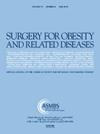Evolution of treated obstructive sleep apneas syndrome after bariatric surgery: an observational retrospective study
IF 3.5
3区 医学
Q1 SURGERY
引用次数: 0
Abstract
Background
The resolution of obstructive sleep apneas syndrome (OSAS) following bariatric surgery appears to be promising for the majority of patients although this resolution does not necessarily exhibit a linear correlation with weight loss. Previous small-scale studies have pinpointed a younger age and preoperative weight under 100kg as predictive factors of OSAS improvement
Objectives
The primary objective was to evaluate the evolution of OSAS in patients treated with continuous positive airway pressure (CPAP). Additionally, we tried to identify potential predictive factors for OSAS improvement postsurgery.
Setting
Brest Hospital, France, University Hospital.
Methods
In this retrospective, observational study we analyzed a cohort of 44 patients who underwent bariatric surgery, between January 2015 and December 2021. Each patient underwent respiratory polygraphy (RP) or polysomnography (PSG) before and after the surgical procedure. We collected CPAP data (including effective pressure and adherence) before and during the 6 months following the intervention.
Results
Within the study population, 68.18% of patients exhibited improved OSAS, as defined as an apnea-hypopnea index of less than 15 per hour. A higher mean oxygen saturation prior to surgery emerged as the sole predictive factor for OSAS improvement. CPAP adherence and therapeutic pressure value, 2 rarely studied parameters, did not show significant difference between improved and nonimproved patients.
Conclusions
The rate of OSAS resolution after surgery is 68.18%, with only a higher mean oxygen saturation before surgery identified as a predictive factor for OSAS resolution.
减肥手术后阻塞性睡眠呼吸暂停综合征的演变:一项观察性回顾研究。
背景:对大多数患者来说,减肥手术后阻塞性睡眠呼吸暂停综合征(OSAS)的缓解似乎很有希望,但这种缓解并不一定与体重下降呈线性相关。之前的小规模研究指出,年龄较小和术前体重低于 100 公斤是阻塞性睡眠呼吸暂停综合症好转的预测因素:主要目的是评估使用持续气道正压(CPAP)治疗的患者 OSAS 的演变情况。此外,我们还试图确定手术后 OSAS 改善的潜在预测因素:法国布列斯特医院,大学医院:在这项回顾性观察研究中,我们分析了 2015 年 1 月至 2021 年 12 月期间接受减肥手术的 44 名患者。每位患者在手术前后都接受了呼吸多导图(RP)或多导睡眠图(PSG)检查。我们收集了干预前和干预后 6 个月内的 CPAP 数据(包括有效压力和依从性):在研究人群中,68.18% 的患者的 OSAS 状况有所改善,即每小时呼吸暂停-低通气指数低于 15。手术前较高的平均血氧饱和度是预测 OSAS 改善的唯一因素。坚持使用 CPAP 和治疗压力值这两个很少被研究的参数在病情好转和病情未好转的患者之间并无显著差异:手术后OSAS缓解率为68.18%,只有手术前平均血氧饱和度较高才是OSAS缓解的预测因素。
本文章由计算机程序翻译,如有差异,请以英文原文为准。
求助全文
约1分钟内获得全文
求助全文
来源期刊
CiteScore
6.70
自引率
12.90%
发文量
570
审稿时长
56 days
期刊介绍:
Surgery for Obesity and Related Diseases (SOARD), The Official Journal of the American Society for Metabolic and Bariatric Surgery (ASMBS) and the Brazilian Society for Bariatric Surgery, is an international journal devoted to the publication of peer-reviewed manuscripts of the highest quality with objective data regarding techniques for the treatment of severe obesity. Articles document the effects of surgically induced weight loss on obesity physiological, psychiatric and social co-morbidities.

 求助内容:
求助内容: 应助结果提醒方式:
应助结果提醒方式:


